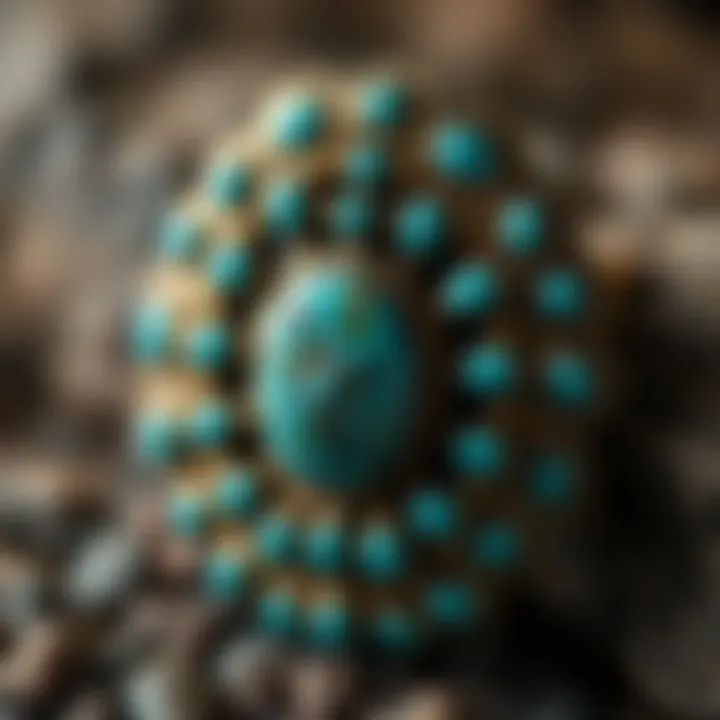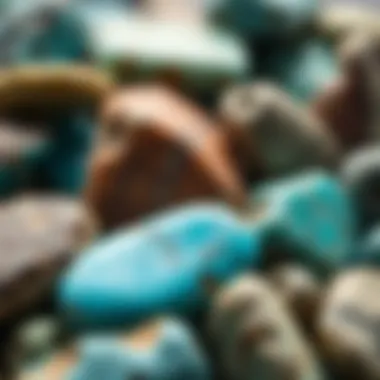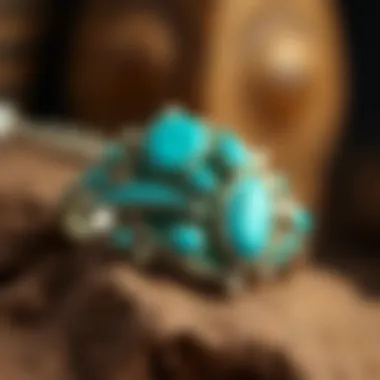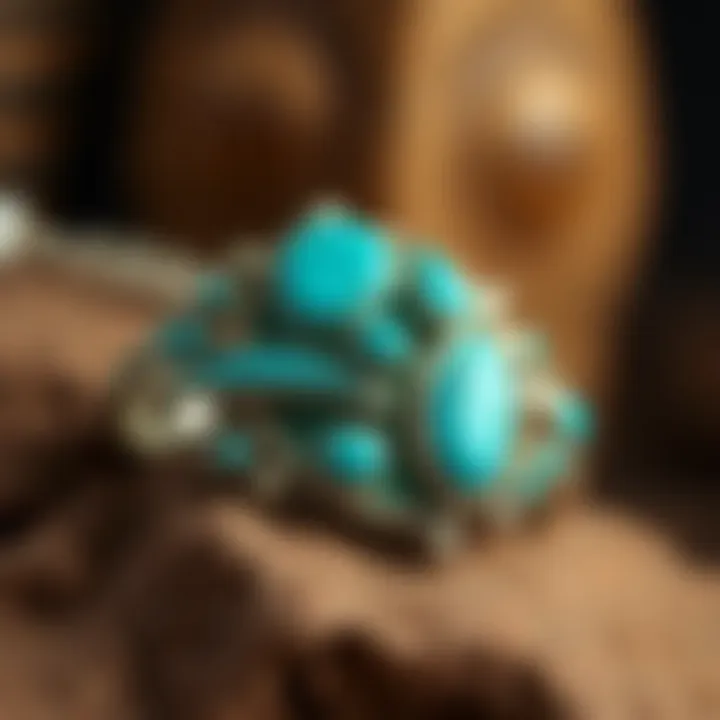Understanding the Worth of Vintage Turquoise Jewelry


Overview of the Topic
Turquoise jewelry has been a fixture in various cultures across the globe for centuries. Often, collectors desire pieces that not only captivate the eye but also hold stories of times past. This exploration into the value of old turquoise jewelry begins by understanding a few key terms, alongside the historical significance that adds layers of depth to these adornments.
Definition of Key Terms
Before delving into the valuation methods, it's crucial to decode some terminology:
- Turquoise: A mineral valued for its blue-to-green hue, primarily composed of hydrated copper and aluminum.
- Vintage: Generally refers to items that are at least 20 years old but less than 100 years, while antique implies older pieces, typically over 100 years.
- Appraisal: A professional assessment to determine the value of an item based on its characteristics.
Historical Significance
Turquoise holds a special place in many societies; it often symbolizes protection, good fortune, and healing. For example, Native American tribes have cherished turquoise for its spiritual and cultural significance. The stone often features in ceremonial jewelry, and its color was believed to connect one to the heavens. The craftsmanship behind these pieces, from silverwork to bead construction, reveals the artistry and skill of their makers.
The historical context plays a vital role in valuation. For instance, a piece sourced from a Navajo artisan in the mid-20th century may have a different standing than one produced in the last decade. These factors — age, cultural provenance, and the artist's reputation — create a tapestry that can significantly affect value.
Types of Collectibles
When categorizing turquoise jewelry, it’s essential to recognize the diverse types available in the market. This section highlights classifications by age, style, and craftsmanship, helping collectors discern value.
Classification of Different Collectibles
The world of turquoise jewelry can be segmented as follows:
- Contemporary: Modern pieces that appeal to current trends but lack the historical depth.
- Vintage: Jewelry that exhibits styles and techniques from past decades but hasn't reached the antique classification.
- Antique: Often rarer finds that showcase traditional craftsmanship, usually fetching higher prices due to their age and uniqueness.
Notable Categories
Within these classifications, several notable styles deserve attention:
- Navajo: Recognized for intricate silverwork and set turquoise, often larger stones set in traditional designs.
- Zuni: Features inlay techniques and often more delicate designs, emphasizing artistry.
- Apache: Known for using natural materials, typically in more rustic motifs.
Understanding Turquoise
Turquoise, a stone that has captivated countless cultures, is more than just a pretty gemstone; it is a piece of history steeped in meaning and craftsmanship. To properly assess the value of old turquoise jewelry, it’s crucial to understand what makes turquoise distinct and significant. This section aims to illuminate the geological, cultural, and artistic attributes of turquoise that contribute to its allure and overall worth.
Geological Formation
Turquoise is formed from a combination of copper and aluminum in the presence of water, creating its striking blue and green shades. The geological sites where turquoise is found can greatly influence its quality and value. Most commonly, deposits are located in arid regions where water played a significant role in the mineral’s crystallization process. Over time, due to weathering and changes in the earth’s surface, the availability and purity of turquoise can shift, affecting its abundance.
In essence, the unique geological formation of turquoise ties back to its rarity. For instance, the famous Sleeping Beauty turquoise from Arizona is noteworthy not only for its sky-blue color but also because its specific geological formation creates a purity unmatched by others. The unique characteristics of each deposit can provide insight into the overall value of old turquoise jewelry.
Types of Turquoise
Natural Turquoise
Natural turquoise stands out as the most sought-after variation. It is not altered or treated, which allows it to maintain its inherent qualities. The key characteristic of natural turquoise is its vibrant color, often ranging from a deep blue to greenish hues depending on the copper and iron content. This authenticity renders it a popular choice among collectors, as it is perceived as a genuine reflection of the earth’s processes.
A unique feature worth noting is its matrix patterns, which add depth and personality to each stone. However, one disadvantage is its susceptibility to damage; without proper care, natural turquoise can lose its luster or become easily scratched.
Stabilized Turquoise
Stabilized turquoise, on the other hand, undergoes a treatment process that enhances its durability. The process involves impregnating the stone with a resin, which provides greater resilience. A key aspect of stabilized turquoise is that it can still retain the beautiful coloration found in natural stones, making it an appealing choice for both artisans and buyers.
What sets stabilized turquoise apart is its wider range of application in jewelry design, as it can be fashioned into more intricate shapes without fear of breaking. However, some purists argue that the treatment may detract from its authenticity and inherent value compared to fully natural pieces.
Imitation Turquoise
Imitation turquoise seeks to capture the appearance of the genuine article but falls short in terms of authenticity and value. Made from synthetic materials or dyed stones, imitation turquoise is often used as an affordable alternative. Its main characteristic is that it visually resembles natural turquoise, but it lacks the geological history and uniqueness associated with the real thing.
The advantage of imitation turquoise is its accessibility. Collectors may find it easier to obtain, and it can be suitable for casual wear. However, for serious enthusiasts and collectors, its value is significantly lower, as it does not have the same cultural or historical significance.
Historical Significance
Cultural Uses
Turquoise is not just a decorative element; it's steeped in cultural significance across various civilizations. Historically, many Indigenous cultures in North America and beyond revered turquoise as a protective stone, believing it brought good fortune and health. Its use in ceremonial items, talismans, and jewelry highlights its essential role in the spiritual and cultural lifeways of these peoples.
One unique aspect of turquoise is how it has been crafted into designs that reflect specific cultural narratives. For example, in Navajo tradition, turquoise is often seen in conjunction with silver, symbolizing harmony between the elements. Understanding these cultural uses is vital for appraisers, as it adds layers of meaning and context to the pieces being evaluated.
Symbolism Across Civilizations
Across various time periods and societies, turquoise has been imbued with rich symbolism. In Ancient Egypt, it was often associated with the goddess Hathor and was thought to bring protection and health. This historical resonance makes turquoise prized not only for its visual appeal but for its connections to spiritual beliefs.
The unique feature of turquoise’s extensive symbolism is that it bridges different cultures and times, which can increase its desirability and market value. A piece of old turquoise jewelry is more than a mere artifact; it’s an emblematic representation of its time, often telling stories and history that can enhance its value significantly.
"In understanding turquoise, we tap into a world where art, culture, and geology converge, rendering each piece a keeper of narratives long past."
With a firm grasp on the geological aspects and cultural significance, collectors and enthusiasts can start to assess the value of old turquoise jewelry more accurately. The subsequent sections will further explore how these foundational elements influence overall worth in the market.
Defining Old Turquoise Jewelry
Understanding what constitutes "old" turquoise jewelry is crucial for collectors and enthusiasts. The term 'old' is not merely a descriptor of age; it’s also about the story and craftsmanship imbued within the piece. It's essential to differentiate these pieces based on age and design influence, as these factors considerably enhance value and desirability.
Criteria for 'Old'
Age Considerations
When it comes to age considerations, the general consensus is that jewelry from before the 1970s qualifies as old. However, the significance doesn't hinge solely on a timeline. Older pieces often showcase craftsmanship that may be difficult to find in more recent creations. These items frequently embody traditional techniques, reflecting the cultural ethos of the time.


The rich history behind these pieces can add a remarkable narrative, making them more appealing to collectors. It's interesting to note how some collectors may argue that even pieces from the 1980s might exhibit qualities of age—if they retain elements of the older craftsmanship. In essence, older turquoise jewelry serves as a time capsule reflecting not just the stone's inherent beauty but also the socio-cultural context in which it was created.
Style Trends Over Time
With style trends over time, the evolution of design significantly contributes to value assessment. Design elements have shifted from intricate hand-crafted works to simpler, mass-produced styles. Older turquoise jewelry often features detailed motifs and symbolism, stemming from cultural significance, making them distinct and collectable.
Collectors often find themselves drawn to the ornate styles of previous decades, as they tend to represent a deeper artistic expression. For example, the more geometric designs from the 1940s are approached differently compared to the flowing forms from the 1960s. Collectors would do well to appreciate these stylistic changes, as they can influence not only the aesthetic appeal but also the valuation of a piece.
Common Styles and Designs
Traditional Native American Designs
Traditional Native American designs hold a place of honor in the realm of old turquoise jewelry. The craftsmanship involved in these pieces reflects intricate meanings and narratives. These designs showcase not just the beauty of turquoise, but also the cultural identity of Native American tribes. Each piece tells its own story through motifs, symbols, and craftsmanship that have been passed down through generations, representing a living history.
A unique characteristic of traditional designs is their use of natural materials and incorporation of storytelling elements, which enhances their collectibility. For instance, a piece that includes specific symbolism related to the Navajo or Zuni culture may fetch a higher price due to its rich narrative.
Modern Interpretations
On the other end of the spectrum, modern interpretations of turquoise jewelry have emerged in the last few decades. These pieces often blend traditional elements with contemporary aesthetics, creating a new narrative for collectors. While they may not have the same historical weight as older pieces, modern interpretations can reflect a current understanding of cultural significance and art.
The key characteristic of modern interpretations is their incorporation of varied materials, such as silver and other gemstones, showcasing innovative designs while still celebrating the turquoise. This makes them appealing, especially for younger collectors keen on a blend of the classic and the contemporary. However, because these pieces may lack the historical context inherent in older designs, they often do not command the same value in the marketplace.
Remember that both old and modern turquoise jewelry hold value; understanding their differences helps collectors appreciate their own tastes and investment choices.
In summary, defining old turquoise jewelry requires delving into criteria that go beyond mere age. It's about an appreciation for the artistry and historical importance woven into every piece. As collectors, grasping this concept enhances not only the joy of collecting but also the effort involved in assessing the true worth of such captivating artifacts.
Factors Influencing Value
When it comes to old turquoise jewelry, understanding the various factors that influence its value can be quite enlightening. The beauty and history surrounding these pieces are not just for show; there’s an intricate web of elements that contributes to their worth in the market. From the quality of the turquoise itself to the craftsmanship involved in creating the jewelry, every aspect plays a significant role. Additionally, provenance and market trends are equally vital, shaping how collectors and enthusiasts perceive and value these gems. A deeper look into these factors allows one to appreciate the uniqueness and allure of each piece.
Quality of Turquoise
Color and Clarity
The color and clarity of turquoise are fundamental aspects that directly influence its value. When discussing color, it's often recognized that the most sought-after turquoise features a vibrant robin’s egg blue. Such a tone is widely adored as it signifies a higher quality, appealing to collectors and jewelers alike.
Clarity is equally critical; clean turquoise with fewer matrix or blemishes tends to fetch higher prices. However, some collectors may prefer turquoise with visible matrix, often seeking the piece's story through its unique patterns. This uniqueness can make each item special, adding value based on personal preference.
Key characteristics
- Vibrancy: The brightness of the turquoise.
- Clarity: The presence or absence of inclusions.
Advantages
- Higher value for pieces with vibrant colors and clarity
- Unique matrix patterns can appeal to niche collectors.
Disadvantages
- Pieces lacking clarity may struggle in the market.
Matrix Presence
Matrix presence refers to the natural veining or web-like patterns found within turquoise. A varying matrix can either enhance or detract from the piece’s appeal, resulting in differing valuations. Some admirers appreciate a rich matrix, viewing it as an artistic element that adds character to the jewelry.
On the flip side, if the matrix overwhelms the turquoise, it might indicate lower quality, which could push potential buyers away. This juxtaposition shows that matrix isn’t just a feature; it can be a deciding factor in the piece’s marketability.
Key characteristics
- Aesthetic Appeal: The visual impact of the matrix patterns.
- Quality Indicator: How matrix interacts with the overall quality of the stone.
Advantages
- Eye-catching elements can attract niche markets.
- Variability in matrix allows for more diverse product offerings.
Disadvantages
- Can negatively impact valuation if perceived as overbearing.
Craftsmanship
Techniques Used
The techniques employed in crafting turquoise jewelry offer significant insight into its value. Traditional methods often reflect cultural heritage and craftsmanship mastery, which can elevate a piece's status in the eyes of collectors. Techniques such as hand-cutting and hand-polishing highlight the artisan’s dedication and skill.
On the other hand, mass-produced pieces made with modern techniques may lack the same allure. They can be seen as less worthy due to a perceived lack of authenticity and craftsmanship.
Key characteristics
- Method of Creation: The craftsmanship’s heritage.
- Skill Level: The artisan’s expertise level in the techniques used.
Advantages
- High demand for expertly crafted jewelry raises valuation.
- Authentic pieces tell a story, boosting their overall worth.
Disadvantages
- Mass-produced techniques lead to lower market prices.
Artistic Expression


Artistic expression within the jewelry design is another crucial factor that influences value. Unique designs or patterns can tell a story or represent specific cultural significances, making these pieces more desirable to collectors. A piece that showcases the unique vision of its creator may be perceived as more valuable than those which replicate standard designs.
However, overly avant-garde pieces could be polarizing, limiting their market appeal. While they might stand out, they may not sell as well to those preferring classic designs.
Key characteristics
- Creativity: Unique and innovative elements in designs.
- Cultural Relevance: Pieces reflecting cultural artistic values.
Advantages
- Unique pieces can attract higher offers at auctions.
- Offers collectors a chance to own culturally significant items.
Disadvantages
- Niche designs might lose mass market appeal.
Provenance and Authenticity
Documentation
Documentation can play a vital role in verifying the provenance of old turquoise jewelry. Certificates of authenticity or historical records not only lend credibility to a piece but can significantly inflate its market value. Collectors often seek thoroughly documented pieces, as they are assurance that the item is genuine and carries a history worth preserving.
However, the absence of documentation might lead to skepticism about the piece's authenticity, potentially diminishing its value.
Key characteristics
- Authenticity Verification: Evidence that confirms a piece’s origin.
- Historical Significance: Adds value to items with documented backgrounds.
Advantages
- Proven certified items command higher prices.
- Historical documentation enhances collector interest.
Disadvantages
- Lack of documentation may lower perceived value dramatically.
Historical Context
A piece's historical context adds another layer of depth to its valuation. Jewelry linked to significant cultural movements or figures often fetches high prices. Context can include everything from the era of creation to historical events it may be associated with, all contributing to the piece's narrative.
However, not every old piece comes with a compelling story or history, which can sometimes render them less valuable in comparison to their counterparts.
Key characteristics
- Cultural Significance: The impact of cultural movements on jewelry.
- Historical Events: Ties to significant events or figures.
Advantages
- Rich histories can significantly uplift valuations.
- Items with intriguing pasts often generate more interest among collectors.
Disadvantages
- Pieces without substantial histories may be undervalued.
Market Trends
Current Demand
Current demand for turquoise jewelry fluctuates and is heavily influenced by fashion trends, celebrity endorsements, and collector interest. At times, authentic pieces can witness significant spikes in value as their popularity surges due to cultural movements or exposure in popular media. Understanding these trends can be crucial for collectors looking to invest.
High demand leads to increased prices, but fluctuations can mean potential risks for sellers, emphasizing the importance of timing in the market.
Key characteristics
- Trends: Reflects changes in fashion or cultural engagement.
- Market Interest: Gauges how much collectors are willing to spend.
Advantages
- Knowing market demand can assist in making informed investment decisions.
- High demand signifies a potential for value appreciation.
Disadvantages
- Market volatility can pose risks for investments.
Price Fluctuations
Price fluctuations in the turquoise jewelry market are pivotal for collectors and sellers alike. This aspect refers to how prices can change over time, influenced by factors such as rarity, condition, and broader economic conditions. Prices might skyrocket during a surge in consumer interest or plummet when market interest wanes, providing both challenges and opportunities.
Monitoring these fluctuations aids in understanding the best times to buy or sell, allowing collectors to maximize returns on their investments.
Key characteristics
- Market Variability: Understands the changing landscape of prices.
- Economic Impact: How economic conditions affect consumer spending.
Advantages
- helps in timing purchases for maximum benefit.
- Knowledge of price trends leads to better long-term investments.
Disadvantages


- Sudden price drops can lead to losses if not monitored.
How to Appraise Old Turquoise Jewelry
Appraising old turquoise jewelry is not just about assigning a price tag; it's about understanding the craftsmanship, history, and the very essence of the pieces. The process allows collectors and enthusiasts to appreciate their jewelry on a deeper level. Accurate appraisal can mean the difference between underpricing a family heirloom or successfully navigating the intricacies of the market when selling a cherished item.
Consulting Professionals
Gemologists
Gemologists are invaluable resources for those looking to appraise old turquoise jewelry. Their specialized knowledge about gemstones makes them a cornerstone in determining authenticity and quality. Gemologists examine specific characteristics, like the stone's composition, cut, and clarity, ensuring that the evaluation is grounded in solid science. The meticulous nature of their work stems from an extensive background in geology and gemology.
A standout feature of gemologists is their ability to use advanced tools such as spectrometers and microscopes, offering insights that the untrained eye may overlook. This level of scrutiny adds significant value to an appraisal since it helps in distinguishing genuine natural turquoise from treated or imitation stones. However, one of the downsides is that their services might often come with a steep fee, which collectors must consider in the cost-benefit equation.
Appraisers
Appraisers, particularly those specializing in fine jewelry, offer a different but complementary perspective on valuing old turquoise pieces. They take a broader view, considering factors like provenance, market trends, and comparable sales. What sets appraisers apart is their experience in the current marketplace, which allows them to grasp nuances that might affect value. They can assess the rarity and demand of old turquoise jewelry, having witnessed firsthand how prices fluctuate over time.
A unique feature of appraisers is their ability to create detailed reports that can be leveraged for insurance purposes or resale. Appraisers typically have longstanding industry connections which can provide additional insights into current buyer interests. On the flip side, their evaluations can sometimes be influenced by market trends, which could overlook the intrinsic value held in specific family pieces or unique styles.
Self-Evaluation Techniques
Visual Inspection
Visual inspection serves as the first stepping stone for anyone looking to appraise their old turquoise jewelry on their own. This method involves examining the piece closely for details such as color variations, inclusions, and overall craftsmanship. The beauty of visual inspection lies in its accessibility—it's something that any owner can undertake without specialized training.
One of the hallmarks of visual inspection is the opportunity it presents to develop a personal connection with the pieces. By closely examining the jewelry, collectors not only learn about their items but also build an appreciation for the craftsmanship involved. Nevertheless, this technique has its limits; without expert knowledge, one may miss subtle discrepancies that could affect the piece's value.
Researching Similar Items
Researching similar items plays an essential role in understanding the market value of old turquoise jewelry. This method requires collectors to delve into resources like auction sites, online marketplaces, or even local antique shops to find comparable pieces. An informed perspective can help in grasping how market demand might affect pricing.
One significant advantage of researching similar items is that it equips collectors with context, allowing them to gauge whether they possess a typical piece or something more exceptional. This kind of groundwork can also lead them to discover the historical narrative of certain designs, enriching the overall understanding of their pieces. The downside is that prices can vary widely based on condition and presentation, making it a bit of a gamble to rely solely on this approach without professional guidance.
Understanding how to approach appraisal—whether through professionals or self-assessment—can empower collectors and enthusiasts to make informed decisions and appreciate the intricate art of old turquoise jewelry further.
Caring for Old Turquoise Jewelry
Caring for old turquoise jewelry is more than just a task; it’s a way to preserve history and protect an investment. The beauty of this exquisite stone can fade without proper attention, compromising not just aesthetics but also value. Understanding how to clean and store these pieces helps maintain their enchantment well into the future.
Cleaning Techniques
Safe Cleaning Solutions
When it comes to cleaning turquoise, adopting safe methods is paramount. A mixture of mild soap and lukewarm water serves as an effective cleaning solution. It gently lifts dirt without damaging the precious stone’ surface. Recommended options include a gentle dish soap or a commercial jewelry cleaner made from non-abrasive ingredients.
The key characteristic of safe cleaning solutions is their gentle formulation. They do not contain harsh chemicals that can dull or discolor the stone. The advantage here lies in their effectiveness combined with safety; it's a win-win for those looking to maintain the deep, vibrant hues of old turquoise.
However, one must be cautious with soaking. Prolonged exposure to water can infiltrate the stone, especially in stabilised types, leading to potential damage over time. Stick to quick cleanings instead.
Preventing Damage
Preventing damage to your turquoise jewelry can save both money and heartache. One vital aspect encompasses avoiding exposure to harsh chemicals, like perfumes and hairsprays, which can leave lasting impressions on the stone’s surface. Always remember to put on the jewelry after applying any cosmetic products.
The unique feature of implementing preventive measures is its proactive approach to care. This strategy helps to ensure that the jewelry retains its original charm and aesthetic appeal. Although preventive care in the form of careful handling may seem cumbersome, the long-term benefits far outweigh the hassles.
Storage Solutions
Optimal Conditions
Storing turquoise jewelry in optimal conditions is crucial for its longevity. A cool, dry place is ideal, as excessive heat and humidity can lead to fading or damage. Individual fabric pouches, particularly made from soft materials, work great in keeping each piece separated, avoiding any unwanted friction.
The distinct advantage of optimal conditions is their ability to stave off deterioration. When pieces are correctly housed, not only do they remain visually appealing, but they also maintain their value. Furthermore, avoid keeping turquoise next to harder stones, like diamonds, which can scratch the softer surface of turquoise.
Preventing Scratches and Loss
To prevent scratches and loss, invest in dedicated jewelry organizers with padded compartments. Each piece can then be stored securely, minimizing movement that could cause damage. Another useful tip is to use anti-tarnish strips in storage boxes; these reduce oxidation that can occur around metalwork in turquoise settings.
The key characteristic of this approach is the emphasis on protection against both physical wear and environmental damage. The benefits of these proactive storage solutions are significant; they significantly reduce the risk of unsightly scratches and the heartache of misplaced jewelry which collectors often face.
"Protecting your old turquoise jewelry means preserving not just the material but the stories they carry along with them."
In summary, attentive care of old turquoise jewelry is essential for anyone who cherishes these adornments. Learning to clean cautiously and store wisely ensures that pieces remain vibrant and valuable, reflecting their historical significance and beauty.
Ending
The culmination of our exploration into old turquoise jewelry significantly underscores the intricate tapestry of culture and value interwoven into these historical pieces. Appreciating this jewelry goes beyond the mere aesthetics; it taps into the legacy of craftsmanship and the cultural narratives that have shaped its existence over the ages.
Value in Cultural Heritage
Old turquoise jewelry acts as a tangible link to histories that many of us may have only read about in books or seen in museums. Each piece carries with it stories of the artisans who crafted it, the cultures that revered it, and the social contexts in which it was worn. For collectors, the allure of these pieces lies in their authenticity. They are not just adornments; they are artifacts that encapsulate the rich customs and traditions related to the people who wore them.
Consider, for example, a piece of Navajo turquoise jewelry. It reflects both the artistry of the creators and a deep respect for the earth and its resources. The intricate designs might tell tales of family lineage or significant events. When one evaluates the worth of such pieces, they must consider how much of their value is tied to these cultural narratives. A disengaged view may ignore the emotional and historical weight these artifacts carry, leading to undervaluation.
Additionally, as time marches on and modern designs dominate the spotlight, the unique heritage of older pieces offers a counterbalance. As collectors continue to seek out the authentic and the historical, the significance of these pieces is likely to grow. Thus, understanding and appreciating their cultural heritage not only enhances their value assessment but also fuels a desire to protect these treasures for future generations.
Future of Old Turquoise Jewelry
Looking forward, the future of old turquoise jewelry appears bright yet challenging. Traditional craftsmanship is at an inflection point where it could either thrive or diminish. The rise in popularity among younger collectors might breathe new life into this segment of the jewelry market, provided they appreciate not just the aesthetic, but also the historical narrative and meticulous artistry that these items embody.
However, the threat from imitation pieces and mass-produced jewelry is ever-persistent. As artisans face environmental changes and evolving market dynamics, they must adapt while ensuring that the quality and authenticity of their products remain intact. The balance between tradition and modernity will determine the sustainability of this craft.
As more collectors turn their attention to the stories behind their pieces, the market can see a significant rise in curated collections that focus on quality and provenance rather than just quantity.
In summary, value in old turquoise jewelry extends well beyond its physical attributes and price tag. It encapsulates stories, heritage, and a reflection of changing societal values. The foresight into future trends speaks to the potential renaissance of appreciation for heritage jewelry; by honoring the past, we can pave the way for its future.















